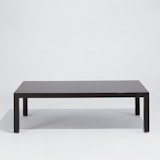Mies van der Rohe and his longtime collaborator Lilly Reich designed this lounge collection in 1927 for the Esters and Lange residences, designed by Mies in Krefeld, Germany. A wonderful example of the syntax, skill and diversity of Mies’ work, the collection was originally specified in leather and reveals van der Rohe’s often-overlooked fondness for traditional furniture styles.
Recognizing the timeless appeal of the designs, KnollStudio brought the Krefeld Collection to production for the first time in 2003. Each piece is based on Lilly Reich’s original drawings, found in the Ludwig Mies van der Rohe Archive at the Museum of Modern Art. The introduction of the Krefeld Collection reflects Knoll’s celebration of timeless, enduring design, and underlines our continuing commitment to celebrate the legacy of Mies van der Rohe through his furniture.























































